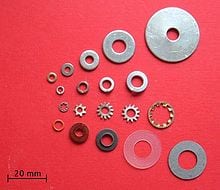 We sell a lot of washers at our company, Fasteners, Inc. in Denver, but most people don’t know how many different kinds there are, what they’re made out of and how to properly use them. A little thing like a washer can be very important. So, we want to share with you everything you wanted to know about the fastener washer and were afraid to ask!
We sell a lot of washers at our company, Fasteners, Inc. in Denver, but most people don’t know how many different kinds there are, what they’re made out of and how to properly use them. A little thing like a washer can be very important. So, we want to share with you everything you wanted to know about the fastener washer and were afraid to ask!
A washer is a disk-shaped, thin plate with a hole in the middle. It distributes the load of a threaded fastener like a nut or screw. Washers can also be used as a spacer, a spring like a Belleville washer or a wave washer, a wear pad, a preload indicating a device, a locking device, and sometimes to reduce vibration like a rubber washer. Most of them have an outer diameter about twice larger than their inner diameter.
Washers are usually metal or plastic. High-quality bolted joints require hardened steel washers to prevent the loss of pre-load due to Brinelling after the torque is applied.
Washers help prevent galvanic corrosion. Usually, a plain washer and a spring washer are placed on a bolt between the nut (on the threaded end) and the bolt head.
There are generally three types of washers.
Plain washers spread a load, and prevent damage to the surface being fixed, and they can provide insulation for electrical.
Spring washers have axial flexibility and are used to prevent any loosening because of vibrations.
Flocking washers prevent fastening loosening by preventing unscrewing rotation of the fastening device; locking washers can also be spring washers.
The American National Standards Institute (ANSI) provides standards for flat washers. Type A is a steel washer at broad tolerances, where precision is NOT important. Type B is flat washers with tighter tolerances where outside diameters are categorized as narrow, wide, or regular for specific bolt sizes.
A flat annulus or ring, often of metal, is used to spread the load of a screwed fastening. A plain washer may be used when the hole is a larger diameter than the fixing nut.
A split washer or spring lock washer is a ring split at one point and bent into a helical shape. This makes the washer create a spring force between the fastener’s head and the substrate, which pushes the washer against the substrate and the bolt thread against the nut or substrate thread, creating more friction and resistance to rotation.
A spring washers is a left-hand helix and allow the thread to be tightened in a right-hand direction only. By using a left-hand turn the raised edge bites underneath of the bolt or nut and the part that it is bolted to, so it resists turning. So spring washers are not effective on left hand threads and hardened surfaces.
An anchor plate or wall washer is a large plate or washer connected to a tie rod or bolt. Anchor plates are used on exterior walls of masonry buildings, and help with structural reinforcement. Being visible, many anchor plates are made in a decorative style.
A torque washer is used in woodworking in conjunction with a carriage bolt. It has a square hole in the center where the carriage bolt square fits. Teeth or prongs on the washer bite into the wood, preventing the bolt from spinning freely when a nut is tightened.
A Belleville washer is also known as a cupped spring washer or a conical washer. This washer has a slightly conical shape, which provides an axial force when deformed.
A curved disc spring is like a Belleville washer, except that it is curved in only one direction, so there are only four points of contact. Unlike Belleville washers, they exert only light pressure.
A toothed lock washer is a serrated washer or star washer and it is a washer with serrations that extend radially inward or outward to bite into the bearing surface. A locking washer has a side tab that can be bent into place against a nut. Metallic or non-metallic, the tab washer notch prevents rotation. Variations include single, multiple, formed, and flat. Lock washers, locknuts, and jam nuts are ways to stop vibration from loosening a bolted joint.
A shoulder washer is a plain washer with an integral cylindrical sleeve. They keep different metal types separate and are used as seals. This term is also used for electrically insulation grommets.
A flat washer has a particularly large outer diameter in proportion to its central hole. They are usually needed to spread the load on thin sheet metal and are named after their use on automobile fenders.
The spherical washer is part of a self-aligning nut, it is a washer with one surface radius. It is designed to be used in conjunction with a mating nut to fix up to several degrees of misalignment between parts.
A wave washer has a wave in the axial direction, which provides spring pressure when compressed. Wave washers do not produce as much force as the Belleville washers.
Washers are small but important for all our customers at Fasteners, Inc. in Denver. There are so many different kinds and uses for washers that we probably haven’t even answered everything you wanted to know about the fastener washer and were afraid to ask. Come to Fasteners, Inc. and we’ll provide all the information, fasteners and washers you need.
No tags for this post.